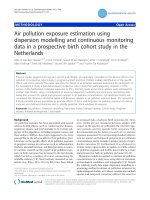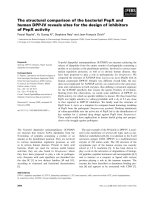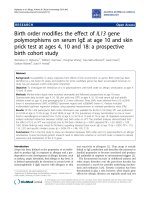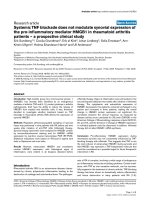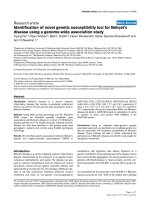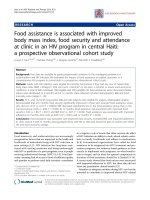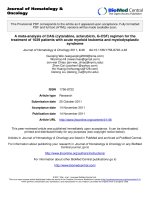Connect MDS/AML: Design of the myelodysplastic syndromes and acute myeloid leukemia disease registry, a prospective observational cohort study
Bạn đang xem bản rút gọn của tài liệu. Xem và tải ngay bản đầy đủ của tài liệu tại đây (1.34 MB, 10 trang )
Steensma et al. BMC Cancer (2016) 16:652
DOI 10.1186/s12885-016-2710-6
STUDY PROTOCOL
Open Access
Connect MDS/AML: design of the
myelodysplastic syndromes and acute
myeloid leukemia disease registry, a
prospective observational cohort study
David P. Steensma1*, Medrdad Abedi2, Rafael Bejar3, Christopher R. Cogle4, Kathryn Foucar5,
Guillermo Garcia-Manero6, Tracy I. George5, David Grinblatt7, Rami Komrokji8, Xiaomei Ma9, Jaroslaw Maciejewski10,
Daniel A. Pollyea11, Michael R. Savona12, Bart Scott13, Mikkael A. Sekeres14, Michael A. Thompson15,
Arlene S. Swern16, Melissa Nifenecker16, Mary M. Sugrue16 and Harry Erba17
Abstract
Background: Myelodysplastic syndromes (MDS) and acute myeloid leukemia (AML) are myeloid neoplasms in
which outgrowth of neoplastic clones disrupts normal hematopoiesis. Some patients with unexplained persistent
cytopenias may not meet minimal diagnostic criteria for MDS but an alternate diagnosis is not apparent; the term
idiopathic cytopenia of undetermined significance (ICUS) has been used to describe this state. MDS and AML occur
primarily in older patients who are often treated outside the clinical trial setting. Consequently, our understanding
of the patterns of diagnostic evaluation, management, and outcomes of these patients is limited. Furthermore,
there are few natural history studies of ICUS. To better understand how patients who have MDS, ICUS, or AML are
managed in the routine clinical setting, the Connect MDS/AML Disease Registry, a multicenter, prospective,
observational cohort study of patients newly diagnosed with these conditions has been initiated.
Methods/Design: The Connect MDS/AML Disease Registry will capture diagnosis, risk assessment, treatment, and
outcomes data for approximately 1500 newly diagnosed patients from approximately 150 community and
academic sites in the United States in 4 cohorts: (1) lower-risk MDS (International Prognostic Scoring System [IPSS]
low and intermediate-1 risk), with and without del(5q); (2) higher-risk MDS (IPSS intermediate-2 and high risk); (3)
ICUS; and (4) AML in patients aged ≥ 55 years (excluding acute promyelocytic leukemia). Diagnosis will be
confirmed by central review. Baseline patient characteristics, diagnostic patterns, treatment patterns, clinical
outcomes, health economics outcomes, and patient-reported health-related quality of life will be entered into an
electronic data capture system at enrollment and quarterly for 8 years. A tissue substudy to explore the relationship
between karyotypes, molecular markers, and clinical outcomes will be conducted, and is optional for patients.
Discussion: The Connect MDS/AML Disease Registry will be the first prospective, observational, non-interventional
study in the United States to collect clinical information, patient-reported outcomes, and tissue samples from
patients with MDS, ICUS, or AML receiving multiple therapies. Results from this registry may provide new insights
into the relationship between diagnostic practices, treatment regimens, and outcomes in patients with these
diseases and identify areas for future investigation.
(Continued on next page)
* Correspondence:
1
Adult Leukemia Program, Dana-Farber Cancer Institute, Boston, MA, USA
Full list of author information is available at the end of the article
© 2016 The Author(s). Open Access This article is distributed under the terms of the Creative Commons Attribution 4.0
International License ( which permits unrestricted use, distribution, and
reproduction in any medium, provided you give appropriate credit to the original author(s) and the source, provide a link to
the Creative Commons license, and indicate if changes were made. The Creative Commons Public Domain Dedication waiver
( applies to the data made available in this article, unless otherwise stated.
Steensma et al. BMC Cancer (2016) 16:652
Page 2 of 10
(Continued from previous page)
Trial registration: Connect MDS/AML Disease Registry (NCT01688011). Registered 14 September 2012.
Keywords: Myelodysplastic syndromes, Acute myeloid leukemia, Idiopathic cytopenia of undetermined significance,
Registry, Treatment patterns, Clinical outcomes, Patient-reported outcomes, Biomarkers, Clonal hematopoiesis of
indeterminate potential (CHIP)
Abbreviations: AML, Acute myeloid leukemia; CHIP, Clonal hematopoiesis of indeterminate potential;
EDC, Electronic data capture; FACT-An, Functional Assessment of Cancer Therapy-Anemia; HEOR, Health economics
and outcomes research; HMA, Hypomethylating agent; HRQOL, Health-related quality of life; ICUS, Idiopathic
cytopenia of undetermined significance; Int-1, Intermediate 1 risk; Int-2, Intermediate 2 risk; IPSS, International
Prognostic Scoring System; IPSS-R, Revised International Prognostic Scoring System; MDS, Myelodysplastic
syndromes; NCCN, National Comprehensive Cancer Network; PRO, Patient-reported outcome; SSC, Scientific steering
committee; UBC, United BioSource Corporation
Background
Myelodysplastic syndromes (MDS) are a heterogeneous group of clonal myeloid malignancies characterized by ineffective hematopoiesis, peripheral blood
cytopenias, and a propensity to transform into acute
myeloid leukemia (AML) [1–3]. AML, which can arise
de novo or secondary to prior myeloproliferative neoplasms or MDS, is defined by ≥ 20 % myeloid blasts
in the marrow or blood, or the presence of specific
cytogenetic abnormalities [4]. In the elderly, AML
and MDS tend to have similar presentation with cytopenias and associated clinical manifestations of these
cytopenias, including infection, bleeding, and the poor
oxygen-carrying capacity characteristic of anemia [2, 5].
MDS and AML are classified using World Health
Organization criteria based on blood counts, morphological criteria, and cytogenetic data [6, 7]. Some
patients with persistent cytopenia(s) may not meet
the minimal diagnostic criteria for MDS, yet no other
diagnosis is apparent [8]. These patients are said to
have idiopathic cytopenia of undetermined significance (ICUS) [8]. Unlike monoclonal gammopathy of
undetermined significance, a clonal state that is a
precursor to multiple myeloma or other plasma cell
neoplasms, ICUS is not a clonal disorder by definition; if a clonal mutation in a myeloid neoplasia–
associated gene is present, the patient is instead said
to have clonal hematopoiesis of indeterminate potential (CHIP) [9]. Although some patients with ICUS
may eventually develop MDS or AML, the proportion
that do is unknown as there is a lack of natural history studies of this condition [9–11].
Although MDS, ICUS, and AML can occur at any age,
they are most common in older patients. In the United
States, the median age at diagnosis of MDS and AML is
approximately 70 years, although exact estimates vary
[12, 13]. Less is known regarding the epidemiology of
ICUS, although the median age reported in the few
existing studies ranges from 61 to 69 years [11].
Because of varying criteria for diagnosis, omission of
MDS in cancer registries until recently, and incomplete
evaluation of many elderly patients with mild cytopenias,
it has been difficult to accurately assess the incidence
and prevalence of MDS [2, 14, 15]. Based on US Medicare claims data, it is estimated there may be ≥ 75 new
cases of MDS per 100,000 people aged ≥ 65 annually in
the United States, making MDS one of the most common hematologic malignancies [2, 15, 16]. AML is the
most common acute leukemia in the United States, with
approximately 20,000 new cases annually [12]. The incidence of ICUS remains unclear.
MDS treatment recommendations are based on individual patient characteristics and disease risk, which can
be assessed using one of several prognostic scoring systems [17], such as the widely used 1997 International
Prognostic Scoring System (IPSS). Patients with asymptomatic lower-risk (IPSS low/intermediate-1 [Int-1] risk)
MDS are often monitored using a “watch and wait”
approach, without specific therapy [18]. Patients with
symptomatic lower-risk MDS are generally treated
with low-intensity therapies such as supportive care
(ie, transfusion support or erythropoiesis-stimulating
agents) or lenalidomide, whereas those with higher-risk
(IPSS int-2/high risk) MDS are often treated more intensively with disease-modifying therapy, including the DNA
hypomethylating agents (HMAs) azacitidine or decitabine,
cytotoxic chemotherapy, or allogeneic stem cell transplant [17]. However, except in younger, healthier patients who can potentially be cured with allogeneic
stem cell transplant, MDS therapy is largely palliative,
and many questions remain regarding the optimal management of patients with MDS [2].
The IPSS was revised (IPSS-R) in 2012 to improve risk
stratification [19]. The IPSS-R includes more parameters
than the IPSS and adds a fifth intermediate risk category
that doesn’t fall cleanly into lower or higher risk, which
may make this fifth category challenging for physicians
to incorporate into routine clinical practice [2, 17, 19].
Steensma et al. BMC Cancer (2016) 16:652
Additionally, a modification of the IPSS-R that incorporates mutational data was recently proposed, providing
enhanced predictive power in patients with MDS across
the course of the disease, regardless of treatment history
[20]. Although the IPSS-R was designed to improve
prognostic classification, prospective studies detailing
how the IPSS-R is being used in clinical practice and
what effect this has on real-world treatment decisions
and outcomes have yet to be conducted.
AML treatment recommendations are largely based on
age, with intensive chemotherapy and transplant generally reserved for patients less than 70 years of age [5].
Patient fitness is also taken into account when determining eligibility for intensive treatment and transplant [21],
and this often requires clinicians to make difficult judgments. Treatment options for older patients with AML
who are not eligible for intensive treatment are limited
and, outside of a clinical trial, typically include HMAs,
low-dose cytarabine, and supportive care [5, 12]. Outcomes in older patients with AML remain dismal, with a
5-year survival rate of 5 % in patients > 65 years of age
in the United States, which lags behind the 38 % 5-year
survival rate in patients < 65 years of age [5, 12].
Although various guidelines exist for the treatment of
patients with MDS and AML, such as those of the National Comprehensive Cancer Network (NCCN) or the
European LeukemiaNet [17, 21–23], patterns of treatment and clinical outcomes in patients with MDS or
AML outside of clinical trials are poorly characterized.
Treatment decision-making can be complex and challenging, especially for elderly patients who may have comorbid conditions and poor performance status [5, 24].
Moreover, a recent survey of physicians treating patients
with MDS indicated that they frequently did not adhere
to NCCN guidelines for length of treatment [25].
There are currently no specific treatments for ICUS
other than addressing factors contributing to cytopenias
when identified, and it is recommended that patients be
monitored with regular follow-up hematologic assessments to surveil for progression to an overt myeloid
neoplasm [11]. No large observational studies have been
performed to date to inform best clinical practices and
to understand long-term outcomes in patients with
ICUS [9, 11].
There are currently gaps in the knowledge of MDS,
ICUS, and AML with regard to diagnostic trends, prognostic categorization, long-term treatment patterns, and
clinical and health-related quality of life (HRQOL) outcomes. Moreover, data from patients enrolled in clinical
trials may not apply to patients treated outside of a trial,
such as those who may lack sufficient resources to travel
to participate in a trial or who are excluded from such
trials due to poor performance status and multiple comorbidities [5, 26, 27]. The Connect MDS/AML Disease
Page 3 of 10
Registry (Clinicaltrials.gov Identifier NCT01688011) is a
multicenter, prospective, observational cohort study of
patients with newly diagnosed MDS, ICUS, or AML in
the United States. This registry aims to acquire robust
data that will be representative of these patient populations in the United States. It is designed to capture patterns of diagnosis, risk assessment, and treatment of
MDS, ICUS, and AML as well as clinical and patientreported outcomes (PROs). This registry represents an
opportunity to document key variables affecting treatment decisions and clinical outcomes in MDS, ICUS,
and AML and to provide new insight into these heterogeneous diseases. The primary objectives of the disease
registry are to:
1. Describe the current and evolving patterns of
diagnosis, prognosis, evaluation, treatment, clinical
monitoring, and outcome measures;
2. Compare actual clinical practice patterns in both
community and academic settings with existing
management guidelines (eg, NCCN);
3. Describe treatment patterns and the associated
short- and long-term outcomes in non-del(5q)
patients and in del(5q) patients with or without
additional cytogenetic abnormalities, including
response, safety, disease progression, and survival;
4. Summarize PROs (eg, HRQOL) and health
economics and outcomes research (HEOR) and their
association with patient characteristics, treatment
regimens, and clinical outcomes.
The disease registry study plan also includes a correlative substudy designed to identify molecular markers
and evaluate their potential impact on prognostication
and/or treatment outcomes.
Methods/Design
The Connect MDS/AML Disease Registry was designed
collaboratively by 2 scientific steering committees (SSCs)
composed of academic and community-based practitioners in MDS (SSC-MDS) and AML (SSC-AML) in
partnership with Celgene Corporation. The SSCs include
experts in molecular and correlative research, as well as
HRQOL, and are responsible for managing the study
with guidance and review by Celgene Corporation.
Setting
Patients will be enrolled at approximately 150 sites in
the United States. Hematologists or oncologists experienced in the treatment of MDS, ICUS, or AML expressing an interest in participating in the disease registry will
be evaluated as site principal investigators. Study investigators must maintain a practice with enough potential
patients to achieve the quarterly enrollment target, and
Steensma et al. BMC Cancer (2016) 16:652
have adequate staff available for coordinating the study
and conducting daily research activities. To best capture
the distribution of routine clinical practice settings in
which patients are typically treated, approximately 70 to
80 % of the sites will be community-based clinics and 20
to 30 % will be academic institutions (defined as affiliated with a medical school).
Sample size
Approximately 1500 patients with MDS, ICUS, or AML
will be enrolled into 4 main cohorts (Fig. 1). The sizes of
the cohorts were chosen to ensure adequate representation to address the critical objectives of the registry. The
first cohort consists of 700 patients with lower-risk
MDS, classified as IPSS low and int-1 risk, and is divided
into subcohorts of patients with del(5q) (n = 250) and
without del(5q) (n = 450). One of the objectives of the
Page 4 of 10
del(5q) cohort is to describe treatment outcomes in
these patients. Currently, the only approved treatment
specific to the del(5q) subgroup is lenalidomide, and approximately 50 % of patients with del(5q) continue past
3 cycles of therapy. Therefore, the expectation is that
125 patients will be on lenalidomide for more than 3 cycles.
For the 250 del(5q) patients with an expected response rate
of 57 % with a 10-mg dose, based on the MDS-003 and
MDS-004 studies, the 2-sided 95 % confidence interval for
this estimate is 0.51 to 0.63. For the 450 non-del(5q)
patients, based on the MDS-005 study, > 60 % of patients,
or approximately 270 patients, are expected to complete
4 cycles of therapy. With an expected response rate of
27 %, the 2-sided 95 % confidence interval is 0.23 to 0.31
and 122 patients are expected to respond, providing
enough patients to explore predictors of response. The
second cohort consists of patients with higher-risk MDS
Fig. 1 Connect MDS/AML Disease Registry study design. Overview of the study design of the disease registry from enrollment through follow-up.
AML acute myeloid leukemia, APL acute promyelocytic leukemia, BM bone marrow, EQ‐5D‐3L EuroQOL. Group 5‐dimension 3‐level questionnaire,
FACT‐An Functional Assessment of Cancer Therapy‐Anemia, ICUS idiopathic cytopenia of undetermined significance, MDS myelodysplastic
syndromes, PB peripheral blood. aMDS diagnosis refers to the date of initial BM aspirate/biopsies for patients. bAML diagnosis refers to the date
of BM aspirate/biopsies or the date of initial PB sample that led to the suspecte diagnosis. cICUS diagnosis refers to patients with ≥ 6 months’
cytopenia in ≥ 1 myeloid lineage who do not meet the criteria for diagnosis of MDS. dReview of BM aspirate/biopsies reports and cytogenetic
report, PB laboratory results, or other reports that led to diagnosis of MDS or AML. Tissue samples are not reviewed; patients whose diagnosis
and/or risk cannot be confirmed are deemed screen failures
Steensma et al. BMC Cancer (2016) 16:652
(n = 200), classified as IPSS int-2 or high risk. Two hundred patients should be an adequate sample size to describe diagnostic patterns and treatment effectiveness in
this cohort. The third cohort consists of patients with
ICUS (n = 200). No sample size estimation was done for
this group since it is viewed as exploratory. The fourth
cohort consists of patients with AML aged ≥ 55 years (n =
400). The age criterion was selected for patients with
AML because of the complexities of treating older patients
due to age-related comorbidities and increased vulnerability to therapeutic toxicities [5, 21, 26]. A sample size of
400 patients should be sufficient to characterize the
complexities of treating these older patients.
Participants
Patients with newly diagnosed primary or secondary
MDS or AML, according to the 2008 revised World
Health Organization criteria [6], or ICUS as defined by
Valent et al. [8] are eligible for inclusion. Patients do not
have to receive treatment to participate. Disease diagnosis
must (1) be confirmed by independent central eligibility
review of clinical diagnostic reports of bone marrow aspirates and biopsies, cytogenetic analyses, molecular testing,
and laboratory results and (2) occur ≤ 60 days prior to giving informed consent. Cohort assignment, including IPSS
risk for patients with MDS, will be confirmed by central
review. Reports of bone marrow aspirates or biopsies must
be available for patients with MDS or ICUS but not those
with AML if the laboratory results show ≥ 20 % blasts in
the peripheral blood. Patients with MDS or ICUS
must be ≥ 18 years of age, and patients with AML
must be ≥ 55 years of age. Patients with suspected or
proven acute promyelocytic leukemia are excluded because these patients benefit from treatment with distinct regimens that lead to favorable outcomes [21].
Patients with MDS or ICUS previously treated with
disease-modifying agents, including prior cytotoxic
agents for MDS (drugs for other cancers are allowed),
azacitidine, decitabine, lenalidomide, or targeted therapies
(eg, FLT3 inhibitors), are excluded. Patients with AML
can have initiated treatment with active agents within
14 days prior to providing informed consent. Prior
use of supportive care, such as transfusions, antibiotics,
iron chelators, erythropoiesis-stimulating agents or other
hematopoietic growth factors, and tumor lysis prophylaxis
is allowed. Patients with AML secondary to MDS could
have received prior therapy with active agents for treatment of MDS. All patients must also be willing and able
to complete the enrollment and follow-up PRO instruments in English or Spanish.
Data collection
Patient data will be entered into the electronic data capture (EDC) system at screening, enrollment (ie, baseline),
Page 5 of 10
and approximately quarterly intervals throughout the duration of a patient’s participation. All decisions regarding
patient care (treatment, response assessment, etc.) will be
determined by the study clinician, as the disease registry is
non-interventional. The EDC will capture clinical outcomes, and patients will be followed for 8 years or until
early study termination, patient withdrawal, or death. For
patients with MDS treated with supportive care alone, the
median survival ranges from 0.4 years in the high-risk
IPSS group to 5.7 years in the low-risk IPSS group [28].
For patients with AML, the 5-year survival rate is 27 %,
whereas for older patients (75–84 years), the 1-year survival is 15 % [12, 29]. Thus, the 8-year follow-up period is
an adequate length of time to acquire robust data on both
the short- and long-term outcomes of patients with MDS,
ICUS, and AML. Follow-up will continue regardless of
whether patients remain on or discontinue treatment. The
total study duration is approximately 11 years, including a
3-year screening and enrollment period and an 8-year
follow-up period.
Information to be captured by the disease registry includes baseline characteristics, comorbidities, frailty
evaluations, diagnostic testing results, treatment, clinical
outcomes, HEOR, and HRQOL, as described in Table 1.
Patient-reported HRQOL data will be collected using
2 instruments: the Functional Assessment of Cancer
Therapy-Anemia (FACT-An), which assesses physical, social, family, emotional, and functional well-being, and fatigue- and anemia-related concerns [30] and the EuroQol
Group 5-dimension, 3-level questionnaire (EQ-5D-3 L),
which assesses mobility, self-care, usual activities, pain
and discomfort, anxiety, depression, and overall health
status [31]. All clinical outcomes will be assessed by
the treating physician as would occur in routine clinical
practice (Table 2) and captured using electronic case
report forms.
Data quality
Certain aspects of the disease registry were designed to
mitigate potential biases that could affect data quality.
To control for selection bias, all consecutive patients at
each site who are diagnosed with MDS, ICUS, or AML
and who are potentially eligible for the disease registry
will be presented with the option of enrolling, until accrual is met. To ensure high-quality data collection, each
site will participate in training specific to registries via
investigator meetings, teleconferences, or webinars, and
a site initiation visit via teleconference or webinar with
United BioSource Corporation (UBC). Ongoing site support and continuing education will be provided throughout the duration of the study. Information bias will be
prevented through the proper handling of missing data
by the EDC system. A major advantage of using an EDC
system for data collection is that it allows real-time,
Steensma et al. BMC Cancer (2016) 16:652
Page 6 of 10
Table 1 Information and assessments captured by the Connect
MDS/AML Disease Registry
Table 2 Key clinical outcomes captured by the Connect MDS/
AML Disease Registry
Type of
Assessment
Variables
Type of Assessment Variables
Baseline
descriptions
• Patient eligibility
• Patient demographics and medical history
• Prior malignancies
• ECOG performance status
• Clinical frailty scale
• Adult comorbidity evaluation (ACE-27)
• Current and concomitant medications
Diagnostic
patterns
• Central eligibility review results
• Hematology/peripheral blood laboratory results
• Bone marrow biopsies/aspirate reports
• FISH analysis, flow cytometry, molecular analysis reports
• MDS and AML diagnostic testing and prognostic
classificationa
Treatment
patterns
• Physician’s therapeutic objective
• MDS and AML therapy, including supportive care
• Changes in MDS and AML therapies
• Transfusion information
• Transplant eligibility and history
• Select concomitant medications
Clinical
outcomes
• Select chemistry laboratory results and other
laboratory results
• Response assessments
• Survival information
• Select AEs
• Events of interestb
HEOR and
HRQOL
• Hospitalization (number, length of stay, treatments
used, etc.)
• Patient-reported HRQOL instruments
AE adverse event, AML acute myeloid leukemia, CNS central nervous system,
ECOG Eastern Cooperative Oncology Group, FISH fluorescence in situ
hybridization, HEOR health economics and outcomes research, HRQOL healthrelated quality of life, ICUS idiopathic cytopenia of undetermined significance,
IPSS International Prognostic Scoring System, MDS myelodysplastic syndromes
a
For MDS, IPSS is used for prognostication. For AML, both cytogenetic and
molecular data are used for risk assessment
b
MDS: second primary malignancies; AML: extramedullary progression
(including CNS) and second primary malignancies; ICUS: progression to MDS
or AML
remote data quality control through edit checks and data
queries that are automated based on validation rules
programmed in advance. This eliminates the need for
on-site monitoring, as the programmed validation rules
will obtain immediate feedback if data are missing or unclear. For example, data fields will be programmed in a
way that prevents leaving an entry blank, and error messages will be generated in real time if values entered outside of the preset range are detected.
Biomarker tissue substudy
MDS and AML are known to have a complex genetic
architecture [2, 6, 10, 21]. A number of clonal abnormalities
are known to have prognostic import in MDS and AML
and are incorporated into assessments of disease risk [19,
21]. However, there are many more for which prognostic or
predictive impact remain to be determined or conclusively
validated. For example, more than 40 recurrent somatic
mutations are described in MDS and are organized into a
Long-term
effectiveness
• Overall survival
• Progression-free survival
• Time to progression to AML
• AML-free survival
Short-term
effectiveness
• Complete remission marrow
• Partial remission marrow
• Complete remission peripheral blood
• Progressive disease
• Transfusion independence
• Erythroid response
• Platelet response
• Neutrophil response
• Progression/relapse after hematologic
improvement
• Cytogenetic response
Safety
• Type, frequency, and duration and outcomes of SAEs
• Onset of SPM and other events of interest
• AEs that lead to treatment discontinuation
• Deaths/reasons for deaths
AE adverse event, AML acute myeloid leukemia, SAE serious adverse event,
SPM, second primary malignancy
number of biological pathways involving pre-mRNA
splicing, epigenetic patterning (including DNA methylation, which influences gene expression), chromatin
conformation, and genome stability [2, 10]. In up to 40 %
of patients with ICUS, MDS-associated genetic mutations
have been observed, but no data exist regarding prognostic implications, and the extent to which these patients
overlap with MDS is unclear, since 10 % of patients aged >
70 years with normal blood counts also have MDSassociated genetic mutations and are said to have CHIP
[9–11].
Therefore, an optional, non-interventional, correlative
substudy will be conducted to explore the relationship between karyotypes, molecular markers, and clinical outcomes. Participating patients will provide a bone marrow
sample, collected as part of routine medical care at screening or later if done prior to active therapy initiation, as
well as peripheral blood samples collected at screening
(also prior to active therapy initiation) and at clinically
relevant post-baseline time points. To aid in the distinction of somatic variants from germline polymorphisms,
oral epithelial cells will be collected. A best effort will
be made to collect all of these samples from study sites
participating in the biomarker tissue substudy. All participating sites will follow a study-specific laboratory manual
to collect and ship the samples to Genoptix, a Clinical
Laboratory Improvement Amendments (CLIA)-certified
laboratory. The substudy objectives are to:
1. Evaluate DNA mutations for further prognostic
classification of MDS and AML subtypes, and
evaluate their potential impact on treatment options;
Steensma et al. BMC Cancer (2016) 16:652
2. Summarize clinical status of patients with and
without mutations;
3. Analyze the correlation between mutations and
allele burden in bone marrow and peripheral
blood samples.
Data analysis
The data generated from the disease registry will describe
diagnostic patterns, treatment decisions and responses,
therapeutic regimens, and associated clinical, HRQOL,
and HEOR outcomes. Routine clinical practice patterns
will be compared with existing management guidelines
(ie, NCCN). The disease registry will be managed by UBC
with oversight by the MDS and AML SSCs. Celgene, in
conjunction with the SSCs, will establish a uniform procedure for analyzing, publishing, and disseminating findings from the disease registry. Data from all study centers
will be combined, and all analyses will be performed
within the disease cohorts. The final analyses will be
performed by cohort once all patients within a cohort
Page 7 of 10
have completed the study. Descriptive summary statistics
will be calculated for the majority of data collected, including demographics, diagnosis and IPSS risk classification, baseline characteristics, medical history, prior
therapy, concomitant medications, treatment regimens
and exposure, safety outcomes, and HEOR. Treatmenteffectiveness outcomes, including response rates, disease
progression, overall survival, other clinical outcomes, and
HRQOL will also be summarized. Potential confounders
will be considered, such as patient’s age group, type of enrolling institution (academic vs community), geographic
location, and other demographic and baseline factors, particularly those that represent patient’s medical history and
socioeconomic background. All statistical analyses will be
conducted using SAS version 9.2 or higher. Statistical testing will be conducted at the α = 0.05 (2-sided) significance
level, and 2-sided P-values and confidence intervals will
be reported. Specialized methods, such as propensity score
modeling, will be utilized to compensate for expected
biases within these nonrandomized groups.
Fig. 2 Locations of accepted study sites. As of November 30, 2015, there were 169 accepted study sites in the United States and Puerto Rico,
including academic, community, and government sites
Steensma et al. BMC Cancer (2016) 16:652
Status of the registry
The first patient was enrolled in the disease registry on
December 12, 2013. As of November 30, 2015, enrollment is 306 patients. There are currently 104 patients
enrolled in the IPSS lower-risk MDS cohort (10 patients
with del(5q) and 94 patients without del(5q)), 80 patients
in the IPSS higher-risk MDS cohort, 0 patients in the
ICUS cohort, and 121 patients in the AML cohort.
There are currently 169 accepted study sites and 149 activated sites (Fig. 2).
Discussion
For patients with MDS and AML, key variables affecting
disease outcomes and survival, such as diagnostic trends,
prognostic characterization, treatment patterns, and PROs,
are inadequately documented outside of clinical trials. Even
less is understood about patients with ICUS due to the
recent definition of this population and its heterogeneity.
As a result, decisions about treatment and management
of patients with MDS, ICUS, and AML are complex,
challenging, and complicated by elderly age, high frequency of comorbid conditions, and poor performance
status or HRQOL [5, 11, 24]. To better understand the
epidemiology, disease course, and long-term outcomes,
this first prospective disease registry of patients with
MDS, ICUS, or AML has been designed and initiated
to capture longitudinal data for a cohort of patients
within a single database.
The Connect MDS/AML Disease Registry represents
an opportunity to synthesize information from several
domains, including clinical parameters, diagnostic practices, prognostic classifications treatments patterns, treatment outcomes, and molecular data in a prospective
fashion. The inclusion of data from such varied domains
will contribute to a large, rich database for future analyses.
Results may provide new insights into diagnostic patterns,
treatment regimens, and treatment sequencing, as well as
how these are associated with clinical outcomes in patients
with MDS, ICUS, or AML in the United States who are
treated outside the context of a clinical trial. The results
will also facilitate evaluation of HRQOL and HEOR outcomes that may be associated with current treatment regimens in routine clinical practice in the United States.
Correlative analyses using molecular data will increase the
understanding of MDS, ICUS, and AML and may reveal
novel prognostic and predictive biomarkers for these
diseases and offer the opportunity to validate newly
discovered biomarkers. As a recent update of the IPSS-R
incorporates mutation data, it will be important to analyze
the impact of these specific prognostic mutations on MDS
cohorts included this registry. Given the ever-increasing
information on molecular mutations in MDS and AML,
this study will aid in describing mutations in the context
of patient diagnosis, treatment, and outcomes.
Page 8 of 10
Additional file
Additional file 1: Ethics Committees/Review Boards Which Approved the
Connect MDS/AML Study. A list of all Institutional Review Boards that have
approved the Connect MDS/AML Disease Registry study. (DOCX 17 kb)
Acknowledgements
This registry is sponsored by and designed in collaboration with Celgene
Corporation. We thank all current and past Connect MDS/AML Disease
Registry steering committee members for their contributions to the design
of the registry, including Gail J. Roboz, MD, and Eyal Attar, MD. The authors
acknowledge medical writing assistance provided by Jennifer Leslie, PhD,
and Stephanie Willard, PhD, of MediTech Media and funded by Celgene
Corporation.
Funding
This registry is funded by Celgene Corporation. The trial was designed by
the investigators in collaboration with Celgene Corporation. The study
design was decided by the sponsor in collaboration with the study steering
committee. All authors and the study sponsor will gather, analyze, and
interpret the data. The corresponding author of any manuscript will have the
final decision to submit for publication. Publications will adhere to the
International Committee of Medical Journal Editors guidelines and Good
Publication Practice (GPP3) guidelines [32, 33].
Availability of data and materials
The study is registered and supporting information can be found on:
/>Connect MDS/AML Disease Registry (NCT01688011). Registered 14
September 2012.
Authors’ contributions
All authors contributed to the Connect MDS/AML Disease Registry design.
DPS, MN, and MMS contributed to the concept of this manuscript. DPS, RB,
CRC, KF, GGM, TIG, RK, XM, DAP, MRS, BS, MAS, MAT, ASS, MN, MMS, and HE
were involved in the creation of the outline and first draft of this manuscript.
DPS, MA, RB, CRC, KF, GGM, TIG, DG, RK, XM, JM, DAP, MRS, BS, MAS, MAT,
ASS, MN, MMS, and HE reviewed and provided revisions to manuscript drafts
and provided final approval.
Authors’ information
C.R.C. is a Leukemia & Lymphoma Society Scholar in Clinical Research
(grant 2400–13) and Pierre Chagnon Professor.
Competing interests
The Connect MDS/AML Disease Registry is sponsored by Celgene
Corporation.
D.P.S. provides consultancy for Genoptix, Amgen and Onconova and serves
on the Connect MDS/AML Steering Committee. M.A. serves on advisory
board, speaker’s bureau, provides consultancy for, and receives grants from
Celgene Corporation. R.B. serves on the Connect MDS/AML Steering
Committee, speaker’s bureau, Data Monitory Committee and provides
consultancy for Celgene Corporation, and provides consultancy for Genoptix
and Alexion. R.B. serves on speaker’s bureau and is involved with patents
and royalties for Genoptix. K.F. and T.I.G. receive salary support from TriCore
Reference Laboratories and provide consultancy for Celgene Corporation.
C.R.C. serves on the Connect MDS/AML Steering Committee for Celgene
Corporation. D.G. serves on speaker’s bureau and provides consultancy for
Celgene Corporation.
R.K. serves on speaker’s bureau and provides consultancy for Novartis and
Incyte Corporation. R.K. receives clinical research funding and provides
consultancy from Celgene Corporation, and receives clinical research funding
from GSK. X.M. provides consultancy for Incyte Corporation and Celgene
Corporation. J.M. serves on speaker’s bureaus for Celgene Corporation,
Alexion, and NORD. J.M. receives grants from Celgene Corporation, NIH,
Evans Foundation, and Alexion. J.M. provides consultancy for Anchillion and
Celgene Corporation. D.A.P. serves on a data review committee and provides
consultancy for Celgene Corporation, and provides consultancy for Alexion,
Ariad, Pfizer, Karyopharm and Agios. M.A.S. provides consultancy for, and
receives grants from Celgene Corporation. B.S. serves on speaker’s bureaus
Steensma et al. BMC Cancer (2016) 16:652
and provides consultancy for Celgene Corporation, Alexion, and Novartis. B.S.
receives funding for the development of educational presentations for
Celgene Corporation and Alexion. M.R.S. serves on a board and provides
consultancy for, and receives stock options with Karyopharm. M.R.S. serves
on advisory boards for Ariad and CTi Pharma, and the Connect MDS/AML
Steering Committee for Celgene Corporation. M.R.S. receives grants from
Celgene Corporation, Astex, and Sunesis. M.R.S. works with DSMB for
Celgene Corporation and Gilead. M.R.S. provides writing assistance support
for Celgene Corporation. M.A.T. provides consultancy to VIA Oncology and
International Cancer Advocacy Network. M.A.T. serves on the Connect MDS/
AML Steering Committee for Celgene Corporation, and advisory boards for
AIM Specialty Health, MDRing, BMS, Xconomy, LifeScience Ventures, Image
32 (ImagingCloud), and Doximity. M.A.T. has stock options with Doximity.
A.S.S., M.N., and M.M.S. are employees of and have stock options with
Celgene Corporation. H.E. serves on boards for DSMG, and Glycomineics
Incorporated. H.E. serves on speaker bureaus for Novartis, Incyte Corporation,
and Celgene Corporation, and provides consultancy for Ariad, Amgen,
Celgene, Daiichi, Incyte Corporation, Janssen, Sankyo, Seattle Genetics,
Sunesis. H.E. receives grants from Agios, Amgen, Astellas, Celetor, Millenium/
Takeda, and Seattle Genetics.
Page 9 of 10
7.
8.
9.
10.
11.
12.
Consent for publication
Not applicable.
13.
Ethics approval and consent to participate
Approval for the study was provided by the institutional review board or
ethics committee at each study site (Additional file 1). All patients must
provide written informed consent and additional informed consent if
participating in the optional biomarker tissue substudy.
14.
Author details
1
Adult Leukemia Program, Dana-Farber Cancer Institute, Boston, MA, USA.
2
Division of Hematology and Oncology, University of California, Davis,
Comprehensive Cancer Center, Sacramento, CA, USA. 3Division of
Hematology and Oncology, University of California, San Diego, Moores
Cancer Center, La Jolla, CA, USA. 4Division of Hematology and Oncology,
Department of Medicine, University of Florida, Gainesville, FL, USA.
5
Department of Pathology, University of New Mexico, Albuquerque, NM,
USA. 6Department of Leukemia, Division of Cancer Medicine, The University
of Texas MD Anderson Cancer Center, Houston, TX, USA. 7Hematology, North
Shore University Health System, Evanston, IL, USA. 8Medical Oncology, Moffitt
Cancer Center, Tampa, FL, USA. 9Yale School of Public Health, New Haven,
CT, USA. 10Department of Translational Hematology and Oncology Research,
Cleveland Clinic Foundation, Cleveland, OH, USA. 11Division of Hematology,
University of Colorado Cancer Center, Aurora, CO, USA. 12Division of
Hematology/Oncology, Vanderbilt University Medical Center/
Vanderbilt-Ingram Cancer Center, Nashville, TN, USA. 13Clinical Research
Division, Fred Hutchinson Cancer Research Center, Seattle, WA, USA.
14
Department of Hematology and Oncology, Cleveland Clinic Foundation,
Cleveland, OH, USA. 15Aurora Research Institute, Aurora Health Care,
Milwaukee, WI, USA. 16Celgene Corporation, Summit, NJ, USA. 17Division of
Hematology and Oncology, University of Alabama at Birmingham,
Birmingham, AL, USA.
15.
16.
17.
18.
19.
20.
21.
22.
23.
24.
Received: 30 December 2015 Accepted: 11 August 2016
25.
References
1. Cazzola M, Malcovati L. Myelodysplastic syndromes–coping with ineffective
hematopoiesis. N Engl J Med. 2005;352(6):536–8.
2. Steensma DP. Myelodysplastic syndromes: diagnosis and treatment. Mayo
Clin Proc. 2015;90(7):969–83.
3. Vardiman JW. Hematopathological concepts and controversies in the
diagnosis and classification of myelodysplastic syndromes. Hematology Am
Soc Hematol Educ Program. 2006;199–204.
4. Liesveld JL, Lichtman MA. Acute myelogenous leukemia. In: Lichtman MA,
editor. Williams hematology. 7th ed. New York: McGraw-Hill; 2005. p. 1183–236.
5. Pollyea DA, Kohrt HE, Medeiros BC. Acute myeloid leukaemia in the elderly:
a review. Br J Haematol. 2011;152(5):524–42.
6. Vardiman JW, Thiele J, Arber DA, Brunning RD, Borowitz MJ, Porwit A, et al.
The 2008 revision of the World Health Organization (WHO) classification of
26.
27.
28.
29.
myeloid neoplasms and acute leukemia: rationale and important changes.
Blood. 2009;114(5):937–51.
Vardiman JW, Harris NL, Brunning RD. The World Health Organization
(WHO) classification of the myeloid neoplasms. Blood. 2002;100(7):2292–302.
Valent P, Horny HP, Bennett JM, Fonatsch C, Germing U, Greenberg P, et al.
Definitions and standards in the diagnosis and treatment of the
myelodysplastic syndromes: Consensus statements and report from a
working conference. Leuk Res. 2007;31(6):727–36.
Steensma DP, Bejar R, Jaiswal S, Lindsley RC, Sekeres MA, Hasserjian RP, et al.
Clonal hematopoiesis of indeterminate potential and its distinction from
myelodysplastic syndromes. Blood. 2015;126(1):9–16.
Bejar R. Myelodysplastic syndromes diagnosis: what is the role of molecular
testing? Curr Hematol Malig Rep. 2015;10(3):282–91.
Valent P, Bain BJ, Bennett JM, Wimazal F, Sperr WR, Mufti G, et al. Idiopathic
cytopenia of undetermined significance (ICUS) and idiopathic dysplasia of
uncertain significance (IDUS), and their distinction from low risk MDS. Leuk
Res. 2012;36(1):1–5.
Howlader N, Noone AM, Krapcho M, Garshell J, Miller D, Altekruse SF, et al.
SEER Cancer Statistics Review, 1975–2012. Bethesda: National Cancer
Institute. based on November 2014
SEER data submission, posted to the SEER web site, April 2015.
Cogle CR, Craig BM, Rollison DE, List AF. Incidence of the myelodysplastic
syndromes using a novel claims-based algorithm: high number of
uncaptured cases by cancer registries. Blood. 2011;117(26):7121–5.
Bejar R, Steensma DP. Recent developments in myelodysplastic syndromes.
Blood. 2014;124(18):2793–803.
Cogle CR. Incidence and burden of the myelodysplastic syndromes. Curr
Hematol Malig Rep. 2015;10(3):272–81.
Goldberg SL, Chen E, Corral M, Guo A, Mody-Patel N, Pecora AL, et al.
Incidence and clinical complications of myelodysplastic syndromes among
United States Medicare beneficiaries. J Clin Oncol. 2010;28(17):2847–52.
National Comprehensive Cancer Network. NCCN clinical practice guidelines
in oncology™ myelodysplastic syndromes. 2015. Version 1.2016.
Garcia-Manero G, Shan J, Faderl S, Cortes J, Ravandi F, Borthakur G, et al. A
prognostic score for patients with lower risk myelodysplastic syndrome.
Leukemia. 2008;22(3):538–43.
Greenberg PL, Tuechler H, Schanz J, Sanz G, Garcia-Manero G, Sole F, et al.
Revised international prognostic scoring system for myelodysplastic
syndromes. Blood. 2012;120(12):2454–65.
Nazha A, Narkhede MS, Radivoyevitch T, Kalaycio M, Patel BJ, Gerds AT, et al.
The Revised International Prognostic Scoring System “Molecular” (IPSS-Rm),
a Validated and Dynamic Model in Treated Patients with Myelodysplastic
Syndromes (MDS). Blood. 2015;126(23). [ASH abstract 607].
National Comprehensive Cancer Network. NCCN clinical practice guidelines
in oncology: acute myeloid leukemia. 2015. Version 1.
Dohner H, Estey EH, Amadori S, Appelbaum FR, Buchner T, Burnett AK, et al.
Diagnosis and management of acute myeloid leukemia in adults:
recommendations from an international expert panel, on behalf of the
European Leukemia Network. Blood. 2010;115(3):453–74.
Malcovati L, Hellstrom-Lindberg E, Bowen D, Ades L, Cermak J, Del Canizo
C, et al. Diagnosis and treatment of primary myelodysplastic syndromes in
adults: recommendations from the European LeukemiaNet. Blood. 2013;
122(17):2943–64.
Klepin HD, Rao AV, Pardee TS. Acute myeloid leukemia and myelodysplastic
syndromes in older adults. J Clin Oncol. 2014;32(24):2541–52.
Steensma DP, Komrokji RS, Stone RM, List AF, Garcia-Manero G, Huber JM,
et al. Disparity in perceptions of disease characteristics, treatment
effectiveness, and factors influencing treatment adherence between
physicians and patients with myelodysplastic syndromes. Cancer. 2014;
120(11):1670–6.
Ossenkoppele G, Lowenberg B. How I treat the older patient with acute
myeloid leukemia. Blood. 2015;125(5):767–74.
Cherubini A, Pierri F, Gasperini B, Zengarini E, Cerenzia A, Bonifacio E, et al.
Are ongoing trials on hematologic malignancies still excluding older
subjects? Haematologica. 2013;98(7):997–1000.
Greenberg P, Cox C, LeBeau MM, Fenaux P, Morel P, Sanz G, et al.
International scoring system for evaluating prognosis in myelodysplastic
syndromes. Blood. 1997;89(6):2079–88.
Thein MS, Ershler WB, Jemal A, Yates JW, Baer MR. Outcome of older
patients with acute myeloid leukemia: an analysis of SEER data over 3
decades. Cancer. 2013;119(15):2720–7.
Steensma et al. BMC Cancer (2016) 16:652
Page 10 of 10
30. Cella D. The Functional Assessment of Cancer Therapy-Anemia (FACT-An)
Scale: a new tool for the assessment of outcomes in cancer anemia and
fatigue. Semin Hematol. 1997;34(3 Suppl 2):13–9.
31. Rabin R, de Charro F. EQ-5D: a measure of health status from the EuroQol
Group. Ann Med. 2001;33(5):337–43.
32. International Committee of Medical Journal Editors. Uniform requirements
for manuscripts submitted to biomedical journals. JAMA. 1997;277(11):927–34.
33. Battisti WP, Wager E, Baltzer L, Bridges D, Cairns A, Carswell CI, et al. Good
publication practice for communicating company-sponsored medical
research: GPP3. Ann Intern Med. 2015;163(6):461–4.
Submit your next manuscript to BioMed Central
and we will help you at every step:
• We accept pre-submission inquiries
• Our selector tool helps you to find the most relevant journal
• We provide round the clock customer support
• Convenient online submission
• Thorough peer review
• Inclusion in PubMed and all major indexing services
• Maximum visibility for your research
Submit your manuscript at
www.biomedcentral.com/submit

